Thanks to a handful of creative poster artists and their large fan groups, many rock concert posters of the late 1960s that today are rightfully considered art, rather than mere advertisements, t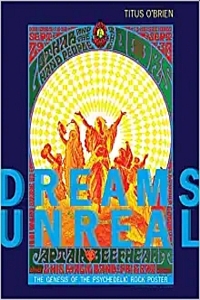 heir most intriguing aspect then and now were the posters’ strong display of psychedelic arrangements, drug-influenced ways of perceiving shapes, names and graphic objects.
heir most intriguing aspect then and now were the posters’ strong display of psychedelic arrangements, drug-influenced ways of perceiving shapes, names and graphic objects.
That is, the artistic effort that was made to have a poster appear like an LSD-influenced vision, which explains the choice of unusual colors, extra-large typesetting and use of objects almost losing their shape.
Some exceptional graphic artists such as Victor Moscoso, Wes Wilson, Bonnie Maclean, Rick Griffin, Lee Conklin and Alton Kelley invented and refined the style, hence they receive much attention in the various chapters of Dreams Unreal.
Contrary to mainstream aesthetics of the mid-sixties, their design style was both rooted and embraced by the American counter culture movement. In total 200 of their posters are reproduced here.
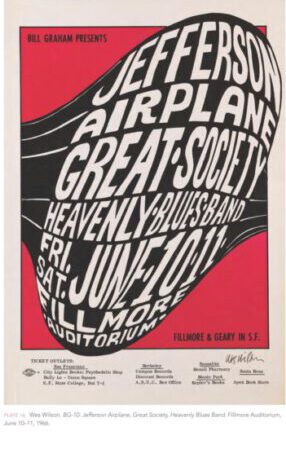 Looking back, a very small group of artists invented and heralded the psychedelic poster movement worldwide, even if their initial target group was the San Francisco hippie community.
Looking back, a very small group of artists invented and heralded the psychedelic poster movement worldwide, even if their initial target group was the San Francisco hippie community.
Their peculiar artistic language, just like the psychedelic rock music, worked on several levels, and expanded the pure visual experience into other spheres and directions.
Hallucinatory effects and fading borders were the model; altogether not an easy thing to do on a two-dimensional canvas or poster.
“Psychedelic artists recontextualized too, willfully raiding history for unreasonable graphic styles. They were fond of collage, using images cobbled from nearly any source – ancient or from that morning’s newspaper – appealing to deep archetypal memories and synchronous collective foci. Such images were then playfully repurposed, inverted and even perverted in unprecedented combinations.”
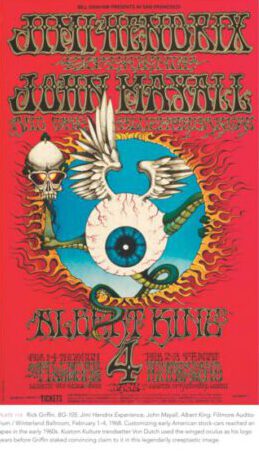 As was true for Pop artists, it was common for psychedelic artists to redefine formats like comic strips or advertising, using them in service for freakier visions and purpose.
As was true for Pop artists, it was common for psychedelic artists to redefine formats like comic strips or advertising, using them in service for freakier visions and purpose.
Accordingly, a number of personalities strongly involved in the development and distribution of psychoactive substances (for instance, LSD and peyote) receive several pages of documentation in the book, like Albert Hofman, Dr. Timothy Leary and others.
In the sixties, San Francisco was the one hot spot for alternative/counterculture, the city hosted rock concerts, readings, alternative housing models, and furthermore, attracted thousands of newcomers who made the city their home. It was rather inevitable that right there the new poster design would evolve. 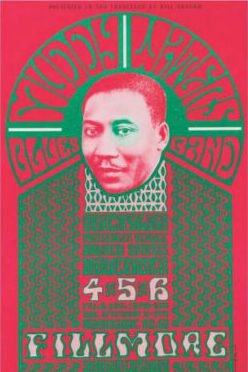
This easily explains the various posters announcing concerts of local bands such as the Quicksilver Messenger Service, The Grateful Dead or Jefferson Airplane, and consequently, the top locations advertised were the Fillmore Auditorium and the Avalon.
Cooperation between the poster creators and contemporary bands did not stop there, as many rock record covers were also designed by the same artists and graphic designers.
Various stages of artistic developments from 1965-1970 are chronicled by editor Titus O’Brien, Andrew Connors, and Scott B. Montgomery.
The designers and their links to the hippie scene and creative centers of the area receive a lot of text. And of course, Ken Kesey’s bus with all of its famous passengers has a separate chapter.
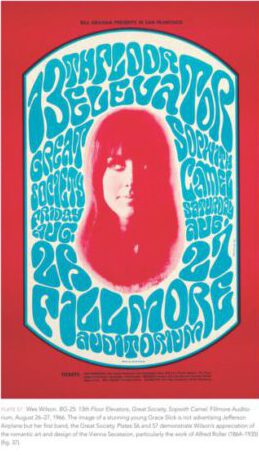
By the early 1970s, however, the genre rapidly lost its fans and fewer and fewer posters of the sort appeared. The book/catalog accompanies a recent 2020 exhibition in the Albuquerque Museum, also curated by O’Brien.
While usually exhibition catalogs dedicate most of their pages to the visual documentation of the works, Dreams Unreal also impresses with extended texts. Actually, a lot of long and highly informative texts make up about a third of the almost 400 pages. However, the majority of the posters have been available in other titles for years.
O’Brien’s title is a beautiful over-sized hardcover book on a unique, if short-lived, period of poster design and hallucinatory ways of rendering psychedelic ideas. The poster prints that invite anybody on a trip back to the heyday of Haighty-Ashbury in the sixties come in first class quality on heavy photo paper.
Review by Dr. A. Ebert © 2020
Titus O’Brien, Scott B. Montgomery, Andrew Connors. Dreams Unreal: The Genesis of the Psychedelic Rock Poster. University of New Mexico Press published in association with Albuquerque Museum, 2020, 392 p.
